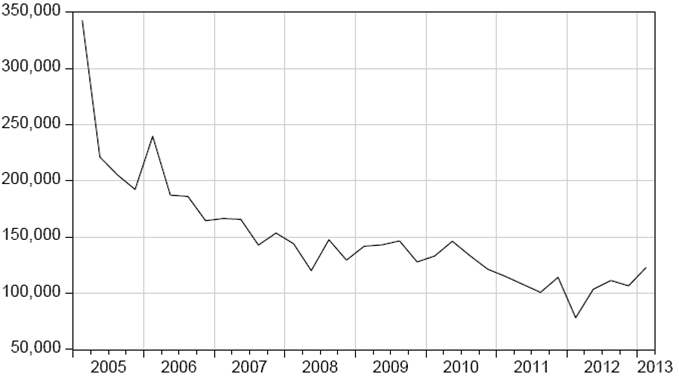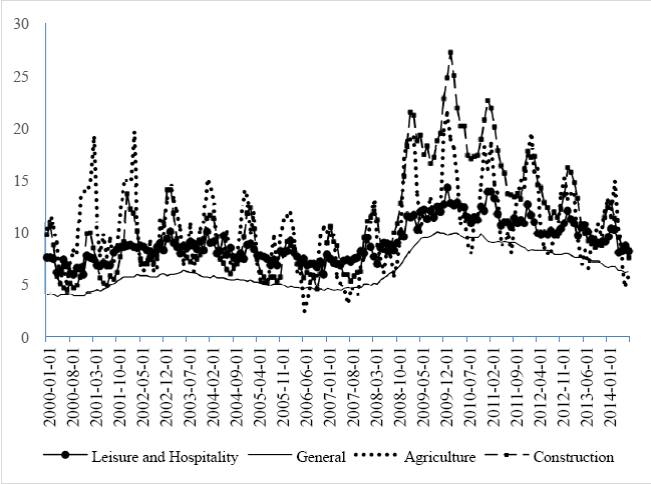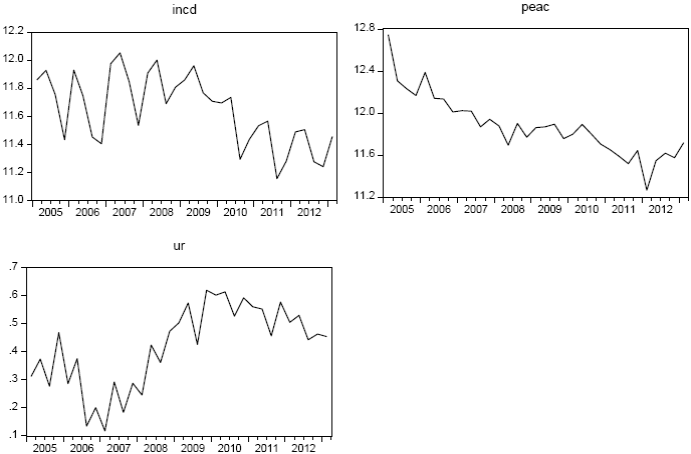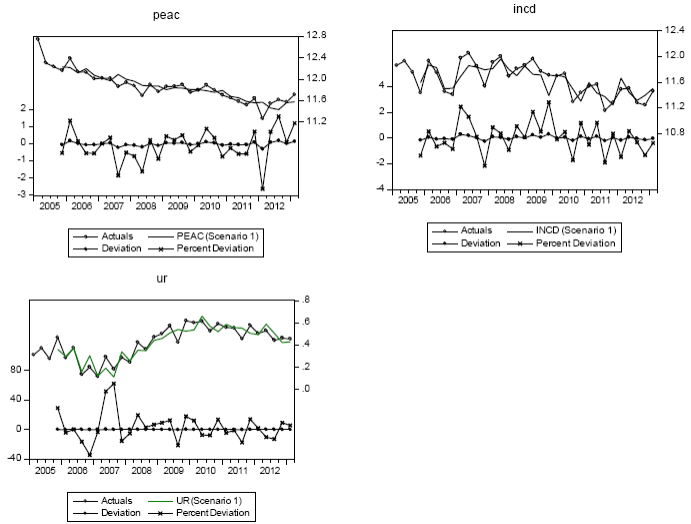Introduction
Remember, remember always, that all of
us, and you and I especially, are descended
from immigrants and revolutionary
Franklin D. Roosevelt
Since 2005, undocumented Mexican migration to the United States has decreased considerably. The reinforcement of US punitive actions aimed at unauthorized immigration has been highly discouraging to migration intentions. Also, the increasing costs (both monetary and life-threatening circumstances), and the rise in relative unemployment rates of the US to Mexico are considered here as primary determinants.
Based on Todaro's (1976) theoretical model -extended by Massey et al. (1993) - a Vector Error Correction Model (VECM(2)) for quarterly data (2007Q3-2012Q3)1 was estimated in order to prove the above-mentioned hypothesis.
We argue that there is a high elasticity of migration intentions to anti-immigration measures, and unit elasticity with respect to the relative unemployment rate (US unemployment divided by unemployment in Mexico).
Although, as explained below, we recognize that migration depends on social, cultural and many other factors, we target this article at economic variables that follow from an extension of Todaro's (1976) seminal model, to explore the possibility that migration is a rational decision, based on the expectation of improving the quality of life, and where implicit costs and risks are considered. The hypotheses put forth are supported by both correct specification and an adequate historical simulation.
The remainder of this article is organized as follows. In Section 2 we discuss estimations on the historical migratory flows of unauthorized Mexican immigrants, immigration policies and their effects on migratory flows. In section 3 the economics of migration are analyzed. In section 4 the econometric issues are presented, as well as the empirical results. Section 5 concludes.
Mexican migration to the United States. Recent facts
In the 2000's, undocumented Mexican immigrants represented little more than 60 per cent of the total population residing unlawfully in the U.S., and the number of unauthorized Mexicans was close to 6.6 million (Table 1, Hoefer et al., 2011). Since 2005 there has been a considerable decline in new arrivals.
Different methods have been used in estimating the number of unauthorized immigrants in the U.S. Some of these estimates are summarized by Hanson (2006). For example, in 2000 the Immigration and Naturalization Services (INS) estimated 4 million, while Passel (2005) had estimated 5.9 million. By using both estimations, we found that the average rate of immigration during 2000-2004 had increased by 5.2 per cent, which suggests that every year little more than 250 000 undocumented immigrants were added to the total.
Since the turn of the century, undocumented Mexican migration to the U.S. has declined in relative terms compared to the previous decade. However, it continued to increase in absolute terms.
These figures are partially consistent with the Northern Border Migration Survey (COLEF, Encuesta de Migración de la Frontera Norte, EMIF 2004) where migratory attempts were placed at 270 000 per year during 2000-2004. These numbers have an upward trend differing from the 1990's, where figures show an increase in both relative and absolute terms. Taking into account migrants with authorized entry (an average of 160 000) makes a total of 440 000 in 2000-2004.
However, migration intentions (PEAC)2 persistently declined from 4.7 per thousand in 2005Q1 to 1.7 in 2010Q4. In absolute terms, the ENOE reported a 70 per cent decline; from 343 000 in 2005Q1 to 102,190 in 2014Q1 (INEGI, 2014) (Figure 1).

Source: INEGI (2014).
Figure 1 Economically Active Population with Intention to Migrate (PEAC), 2005Q1-2014Q1
The disadvantage of using ENOE (Encuesta Nacional de Ocupación y Empleo) data is that, up until now, no proven methodology has been able to calculate the magnitude of migratory flows. However, it can be used as a time series for migratory flow, which is not the case with the population census, the Mexican Migration Projector (MMP), the EMIF or any other records for that matter.
According to Hanson (2006), unauthorized Mexican immigration primarily depends on total migratory volumes (flows) and the number of attempts to cross the border and border apprehensions. This author argues that after being stable in the first half of the 1990's, intentions to migrate started to decline, and by 2005 they had reached the level of the mid-1970s. This can be attributed to border officials reinforcing surveillance and toughening punitive actions that dissuaded migration.
Recent evidence, both in migration intentions (PEAC) as well as estimations of unauthorized immigrants residing in the U.S., appears to confirm this drastic decline, but adds some other crucial factors.
Economic causes of migration
Many factors can drive the decision to migrate. Some of the first to be studied by Ravenstein (1885) were climate, overpopulation and legal restrictions.
More recently, De los Ríos and Rueda (2005) suggest that international migration flows, which originate primarily in poor countries, are related to the low capital intensity of these regions vis-à-vis advanced markets with higher intensity. As such, this gap incites migrants with the guarantee of higher productivity and wage levels.
To understand the migratory issue between Mexico and the United States we part from a variation of the model developed by Massey et al. (1993), which is a cost/benefit model that estimates the probability to emigrate. The model yields a numerical value ER, (the expected return from emigrating), for t periods at the moment of departure (0). The higher the ER, the higher the PEAC. According to Massey et al. (1993), the decision to migrate can be derived from the following equation 1:
Where:
ER (0) = net return expected for n periods at the moment of departure "0", P1(t) = the probability of not being deported, P2(t) = probability of obtaining a job in the country of destination, Yd(t) = destination country wage, Yo(t) = country of origin wage, P3(t) = probability of obtaining a job in the country of origin, r = discount factor, C(0) = total cost of migrating (including physical and psychological costs due to crime).3
With respect to these violence-related costs, it is worth mentioning that they have increased systematically since the last decade, reaching a peak during the administration of Felipe Calderon, as a collateral effect of the official war against organized crime (Walser et al., 2011).
It is estimated that between 80 and 95 per cent of illegal immigrants hire the services of human traffickers (coyotes) to cross the border. The main risk is being left behind due to fatigue or dehydration, as the crossing routes run through the desert. 30 per cent of the 390 people whose bodies were recovered in 2008 died due to exposure to extreme heat (Walser et al., 2011).
Regarding the kidnapping of illegal migrants, between September 2008 and February 2009 there were a total of 9 758 cases, with the number increasing to 11 333 for the months of April through September 2010. In average, more than 400 people are kidnapped every day. In 2008-2009, 55 per cent of reported kidnappings occurred in the southern regions of Mexico; by 2010 the fraction had risen to 67.4 per cent. Also in the period 2008-2009, of the 2 525 cases of kidnapping in which the exact site of abduction was determined, almost 98 per cent occurred near the train tracks or on trains (Walser et al., 2011). All in all, it is estimated that the intention to cross the border results in more than 22 000 victims each year.
Illegal immigrants are also subject to extortion by federal and local authorities, most often at unlawful immigration checkpoints. Lastly, injury and death due to boarding freight trains that cross the country have also been identified as an important risk.
Additionally, the variable Index of Non-Criminal Deportations (INCD) is a powerful, discouraging factor for migration. This is reflected in the fact that, as mentioned in Massey et al. (2009), a large percentage of migrants hire the services of coyotes, due to the growing complexity of border crossing.
The costs of the choice whether to migrate or not have thus increased, since now aspiring migrants must estimate whether the cost of paying the coyote will be compensated by obtaining a job and remaining in the United States.
Therefore, deportations have become a highly relevant variable, since the estimated cost of the choice whether to migrate or not involves the decision of whether to migrate independently or to hire assistance.
The easier it is to cross the border, the less the demand for the services of coyotes. And, when this undertaking becomes more difficult (i.e. when the number of deportations increases), more migrants will demand assistance, increasing its price.
In the end, to a higher difficulty of crossing the border and staying in the United States corresponds a more expensive crossing fee and a higher risk to the physical integrity of the migrant. And, to an easier and safer crossing and permanence, correspond a lower total cost (both economic and personal), which is the reason why an increase in the number of deportations has a direct impact on the cost of migration.
All these variables are considered costs effects, C in equation (1).
The above risk factors are also highly relevant to understanding the drop in the dynamics of migration intentions (PEAC). Migration itself continues to be, of course, a behavior that can open new life opportunities, but the worsening costs and personal risk involved constitute an internal factor that discourages PEAC.
Formerly, the most accepted hypothesis among academics was that the Great Recession (2007-on) was one of the most important causes for the decline in Mexican migratory flow to the U.S. Following this vein, this article also includes relative unemployment (U.S. to mexican unemployment ratio).4
However, while the critical drivers of the global recession started in the U.S. housing sector, where most of the mexican migrants found jobs, the drop in the number of migrant workers can be observed in several statistics since 2005. Furthermore, with the U.S. reinforcing immigration policies and shielding the border, and also intensifying efforts to round up undocumented migrants inside the U.S. in work places and public gathering sites, deportations seem to have increased, causing a decline in mexican migratory flow and an increase in voluntary returns.
Figure 2 depicts unemployment rates in the construction, leisure and hospitality, recreational and agricultural sectors. Also shown are the rates of unemployment in the U.S. between October 2000.1 and 2014.7. A great disparity between unemployment in these economic sectors can be detected, but also that by the end of 2009 unemployment in construction and agriculture doubled.

Source: US Bureau of Labor Statistics (2014).
Figure 2 U.S. General Unemployment and Migrant Occupational Sectors, 2000:1-2014:7
In the regional perspective, unemployment caused by the Great Recession in the U.S. affected jobs for mexican migrants. The two states with the highest concentration of mexican undocumented workers, California and Illinois, presented higher levels of unemployment than the national average.5
The strategy to control migration has shifted from a focus on dissuasion to detentions, trials, deportations and future penalizations to undocumented immigrants residing in the U.S. In the past, a decline in apprehensions used to be an indicator of the efforts to control the border and suggested more lax restrictions at the border. But this is not so according to our analysis. The decline in detentions is due to a weaker migration flow into the U.S.
Between 2002 and 2010, around 1.8 million mexican illegal immigrants were deported, representing between 30 and 40 per cent of the migrant population of some regions (Hagan et al., 2011).
Econometric issues
Methodology
Based on a modified version of equation (1), a VECM(2) was estimated. Three crucial variables constitute the information system:
y: {urt, peact, incdt }.6
Variables are in logarithms, as indicated by the lowercase notation.
Given that all variables are stationary in their first differences (see unit root tests in Table 1A in the appendix), it is appropriate to use the Johansen (1988 and 1992) cointegrating procedure by which long-run relations and the corresponding error correction model can be obtained (Figure 3).

Source: the data was taken from the National Occupational and Employment Survey (ENOE) and from the National Institute of Statistics and Geography (INEGI), and refers to Mexico's economically active population with intention to migrate (PEAC). Mexico's unemployment rate (u) was taken from the same source; deportations of non-criminal immigrants (INCD) was taken from the Enforcement Integrated Database of the U.S. Department of Homeland Security (2011); and the US unemployment rate (uss) is from the U. S. Bureau of Labor Statistics (2014). The relative unemployment rate of US to Mexico (uss/u) is ur. There is no previous data and thus the period is considered as long term.
Figure 3 Historical variables (logs)
The let the data freely speak approach (Hoover et al., 2008), by which non-a priori restrictions are imposed was followed. A crucial point is determining how many cointegrating relations exist, as well as the structure of the error correction mechanism. Therefore, a careful marginalization process (Hendry, 1997) was carried out, based on the theoretical issues contained in equation (1).
It is convenient to point out that the economic theory usually refers only to long-run equilibrium relationships, leaving the dynamic adjustments to mathematics and to the data structure. According to the modern time-series approach, it is necessary to deal not only with the long run parameters but also with the short run disequilibrium by letting the data freely speak. This is a specific feature of the VECM methodology because it allows the data to indicate the adjustment properties and, therefore, the statistical relation of the series in the short and long run (Hoover et al., 2008; Juselius, 2006; Lütkepohl and Krätzig, 2004).
The necessary condition for these models to be solved is that at least one cointegrating vector (r = 1) exists, from which it shall be concluded that the range of the system is β´= r × k and that Yt β´ Yt-1 is a vector of r × 1 lagged disequilibrium terms (Patterson, 2000: 634), where k refers to the number of variables of the information system (y).
Johansen's (1988) general unrestricted VECM in reduced form can be expressed as:
ΔΥ=ΓΔΥt-1+αβΎt-1+B*D+ζt (2)
Where D accounts for the exogenous or dummy variables.
Results and discussion
According to the trace statistic and the maximum eigenvalue tests,7 only one cointegrating vector was found, and therefore an unrestricted VECM(2) for 2007Q3-2012Q3 with intercept was specified, obtaining the following outcome:
(3) peact = 40.86 - 2.63 * incdt - 1.04*urt + et
t (5.56) (-6.22) (-2.00)
Urzua = 9.86(0.99); LM(6) = 0.81(0.52); White(n.c.) = 105.72(0.38).
Two impulse dummies8 were included to capture outliers.
The estimated VECM features the following error correction vector α (transposed):
In addition to passing all the tests for correct specification and stability,9 the VECM displays highly relevant results in terms of our goals.
Since the parameters express constant elasticities, it is possible to make straightforward comparisons among them. The variable that most affects (expulsion factor) the intention to cross the border (peac) is non-criminal deportations, with a high elasticity (2.63), while relative unemployment (ur) is elastic (1.04). Moreover, since α21 is statistically significant and negative, we reject the hypothesis that ur is weakly exogenous to peac; therefore ur must be modeled itself, following Johansen (1992).10 The latter empirical finding suggests that U.S. and mexican labor markets exhibit a high degree of integration, and that migration works as a communication channel.
The model yields a close approximation to the data generating process, since the historical simulation (calculated with the Broyden algorithm) replicates the data fairly well, as can be seen in Figure 4.

Source: own calculations. See definition in the Appendix.
Figure 4 Historical simulation (Broyden's method) of the information system (logs)
Conclusion and final comments
Since 2005, a sharp contraction in mexican undocumented migratory flow to the United States has been observed, despite some crucial factors: i) Mexico's slowdown in economic growth (since 1982); ii) high unemployment rates: iii) skyrocketing informal economy11 and iv) lower salaries compared to those of the U.S. It was thus the objective of this article to find the main determinants for this seemingly paradoxical behavior. Todaro's canonical migration model was the analytical base that led to a cointegrating analysis, which confirms and gauges the effect of the individual variables.
The empirical results confirm the validity of migration economics, given that the deterioration in domestic economic conditions increases unemployment and consequently creates the intention to migrate. At the same time, the United States' anti-immigration actions and rising unemployment, as well as the difficulties to cross the border have reduced the intentions to do so.
On the other hand, the rise in non-criminal deportations also reduces intentions to migrate. Both the works of Massey (2007) and Cornelius and Lewis (2007) mention rising monetary costs, risks and dangers, and the deaths of migrants that trek through isolated areas as factors that have also reduced attempts to cross into the United States. Now -and as an additional factor- we have rampant, international organized crime in Mexico that dramatically affects the undocumented migrant workers and should be considered a crucial and new psychological dissuasion factor.











 nova página do texto(beta)
nova página do texto(beta)







